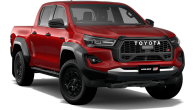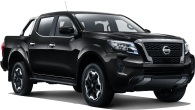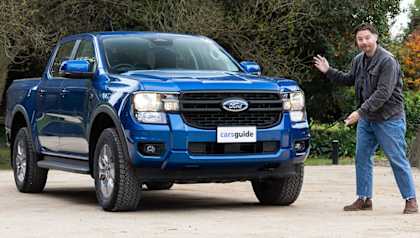The BYD Shark 6, Australia’s first plug-in hybrid electric ute is big news for many reasons.
But while plenty of people are very excited about the Shark – throwing around descriptions like “ground-breaking” and “game-changing” – this Chinese-made ute now faces some stiff competition in the form of recently launched plug-in hybrid electric versions of the Ford Ranger and GWM Cannon Alpha.
So is this Shark – with no 4WD, no low-range gearing and no diff-locks – a mere novelty as a plug-in hybrid electric ute, or is it a clear sign of things to come?
More importantly, is it any good off-road?
Read on.
BYD Shark 6 2026: Dual Motor Premium
| Engine Type | Turbo 4, 1.5L |
|---|---|
| Fuel Type | Premium Unleaded/Electric |
| Fuel Efficiency | 7.9L/100km (combined) |
| Seating | 5 |
| Price From | $57,900 |
Price and features – Does it represent good value for the price? What features does it come with? 8/10
8 / 10
The BYD Shark 6 is a five-seat dual-cab ute available as one grade only, with a competitive price tag of $57,990 (excluding on-road costs).
Standard features include a 15.6-inch rotating touchscreen multimedia system (with wireless Apple CarPlay and Android Auto), a 10.25-inch digital instrument cluster, a head-up display, wireless charging, a 360-degree camera, a tyre-pressure monitoring system and more.
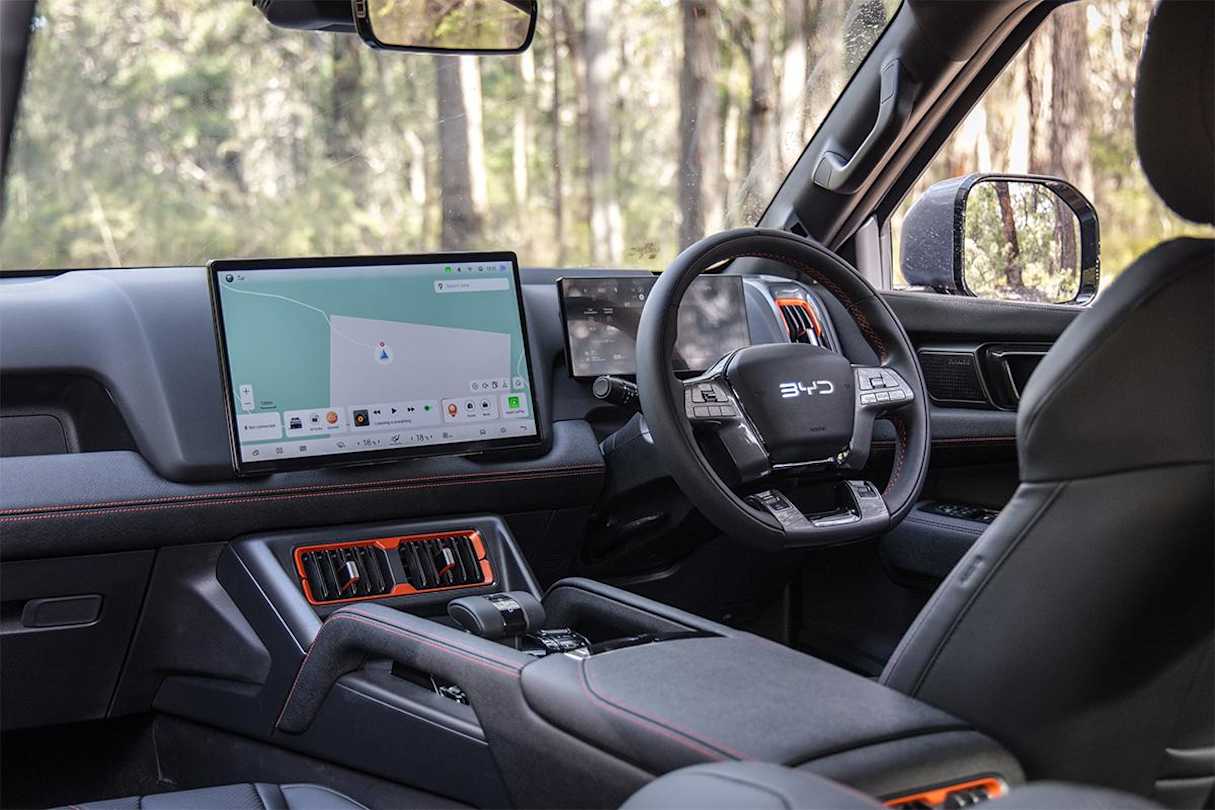
It also has an eight-way electrically adjustable driver’s seat, a four-way electrically-adjustable front passenger seat, heated and ventilated front seats, a leather steering wheel, a 12-speaker stereo system, and a hydraulically-assisted tailgate.
Exterior paint choices include Great White, Tidal Black, Deep Sea Blue and Outback Orange.
Design – Is there anything interesting about its design? 8/10
8 / 10
The Shark 6 is easy on the eyes – if that’s your sort of thing.
When designing contemporary utes and 4WD wagons, car-makers are guilty of usually sticking to a tried-and-true inoffensive formula – so much so that you’d actually be hard-pressed to tell any of these vehicles apart in a line-up or shopping centre carpark.
And if a car-maker dares to stray from that formula – I’m looking at you, Kia – then there’s a high risk of a passionate, some might say over-the-top, backlash (Tasman, anyone?).
Well, BYD has avoided alienating the car-buying public by going with styling that manages to be fresh and interesting, while not dividing opinions as the Tasman has.
The Shark 6 has a big bluff front end, slyly pronounced wheel arches, 18-inch alloys, chunky side steps and a distinctive squared-off rear.
As for cold-hard dimensions, the Shark 6 is 5457mm long (with a 3260mm wheelbase), 1971mm wide (1660mm wheel track), 1925mm high and has a kerb weight of 2710kg.

Practicality – How practical is its space and tech inside? 8/10
8 / 10
The Shark 6's cabin is very practical, but it also has a high degree prestige about it. It doesn’t do it any justice to describe it, you have to experience it for yourself – it’s that good.
Fit and finish and build quality are impressive. In terms of look and feel, there are plenty of soft-touch surfaces inside.
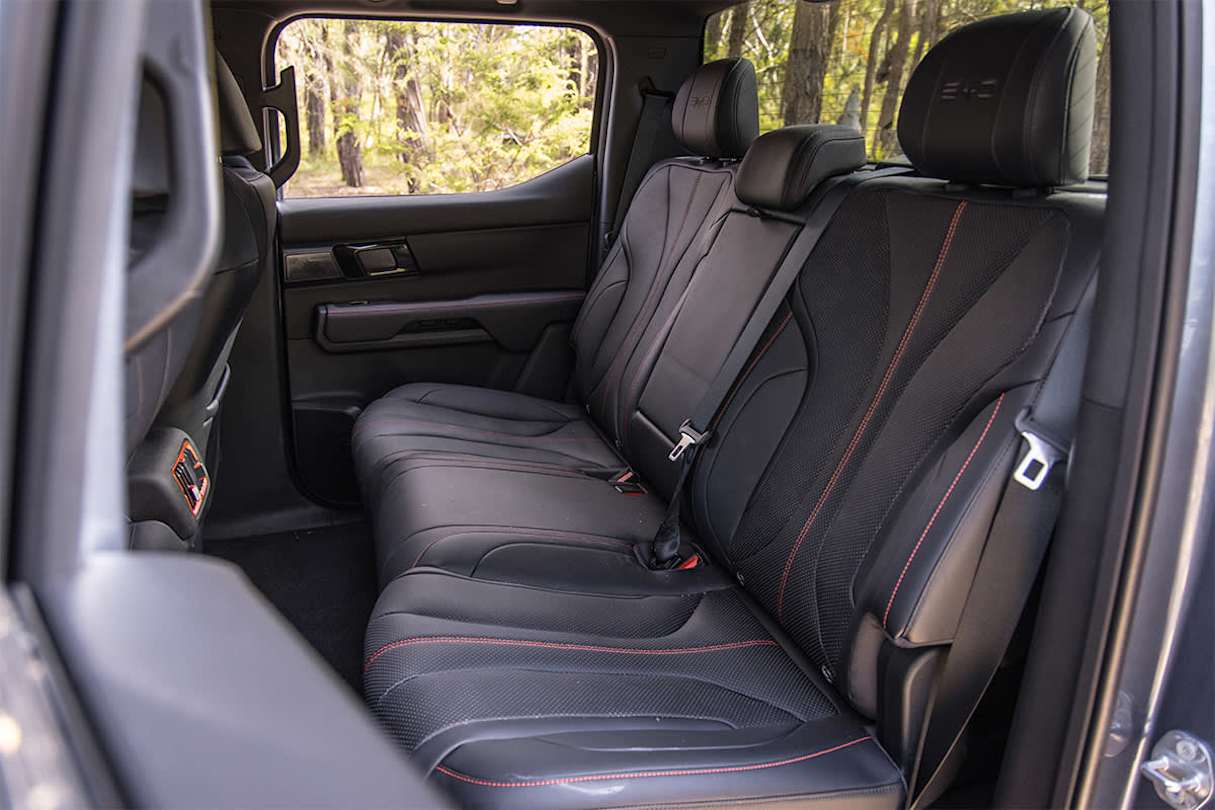
The driver and front-seat passenger seats are comfortable and everyone in the cabin is well looked after in terms of charge points, storage areas and general amenities.
Using the 15.6-inch rotating touchscreen and the 10.25-inch digital instrument cluster, you can control most aspects of in-cabin comfort and entertainment – but sadly neither of those features will help you manage your bickering back-seat teenagers.
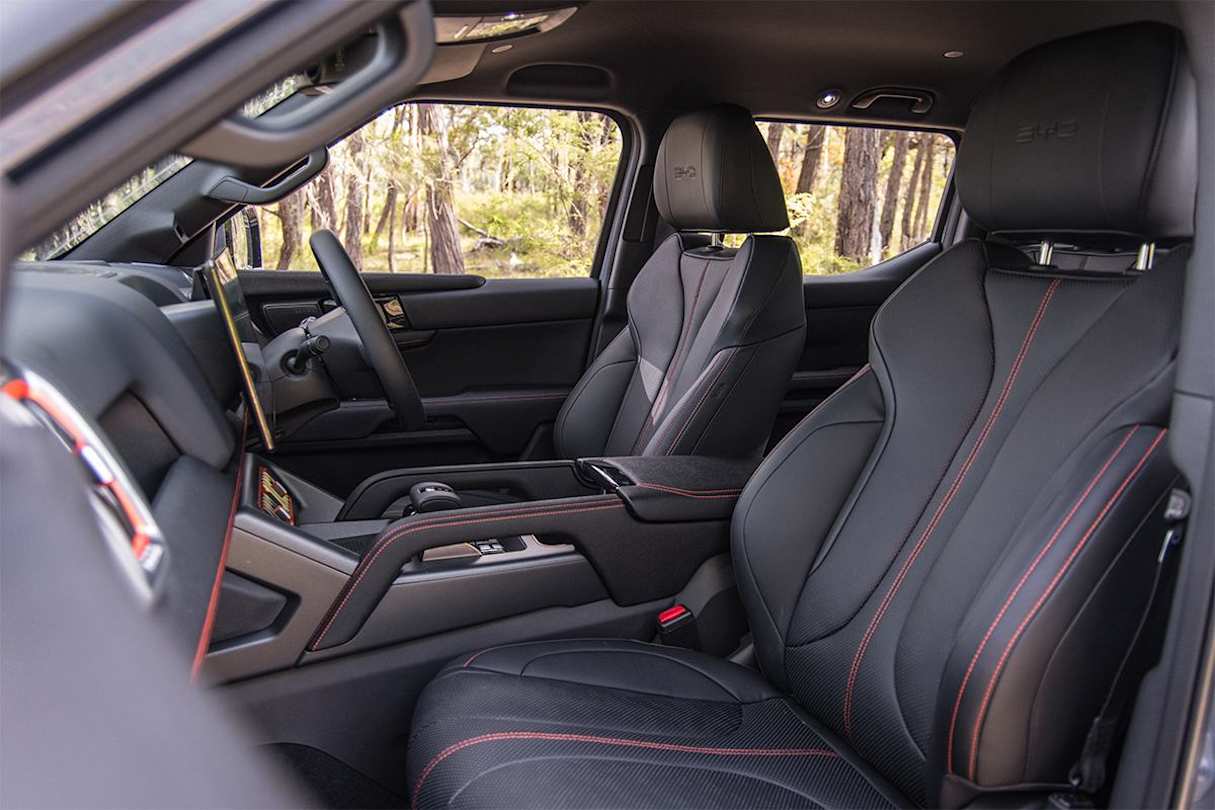
In the back seat, there’s a surprising amount of room, and it is very comfortable. So why are those teens still bickering? Your guess is as good as mine…
All in all the Shark's cabin is a very impressive space.
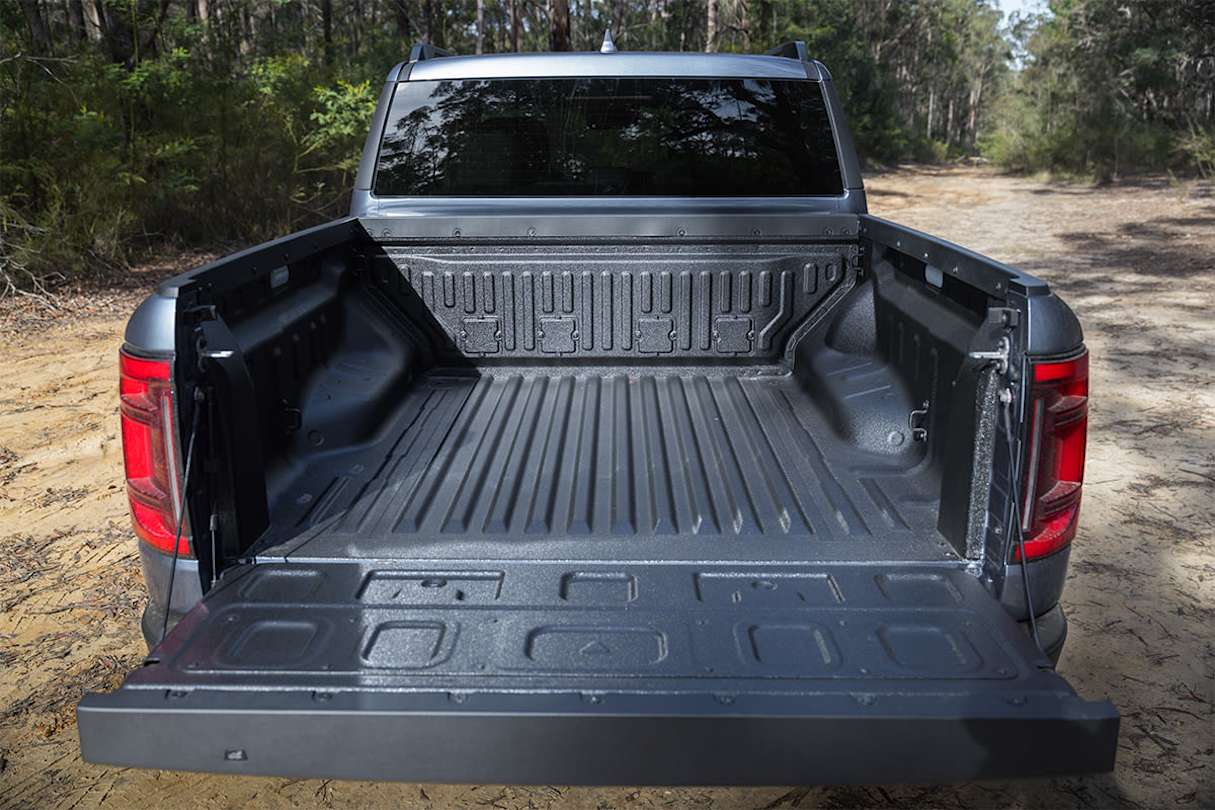
The Shark’s tray is 1520mm long, 1500mm wide (1224mm between the wheel arches) and 517mm deep. So it’s shorter, narrower and shallower than a Ranger tray (1547mm long, 1584mm wide, 529mm deep).
It has a sturdy looking tub liner, six tie-down points, a light and a three-plug power outlet.
Under the bonnet – What are the key stats for its engine and transmission? 8/10
8 / 10
The BYD Shark 6 has a turbocharged 1.5-litre petrol engine – producing 135kW and 260Nm – and it has an electric motor at the front (170kW/310Nm) and rear (150kW/340Nm).
Maximum total outputs for the whole hybrid system are 321kW and 650Nm.
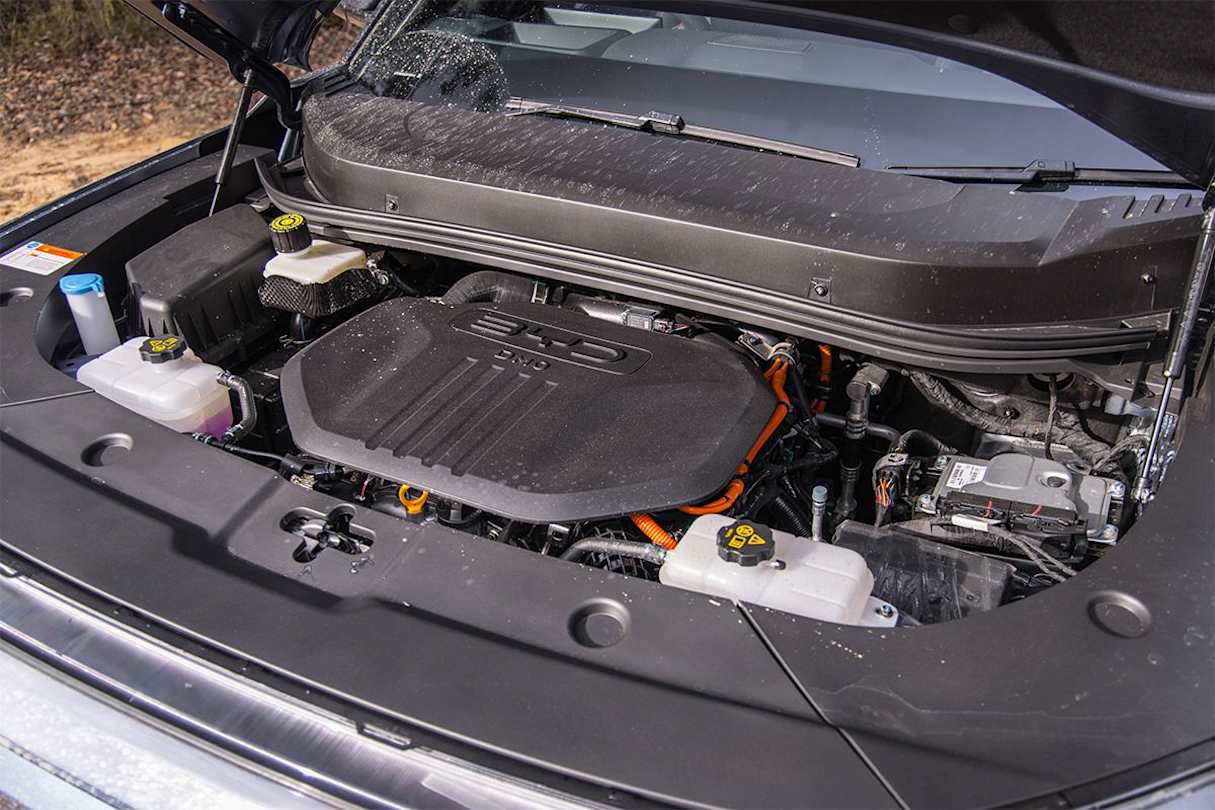
It has a single-speed reduction gear / dedicated hybrid transmission (which enables electric-only driving and hybrid operation, switching between modes based on throttle demand and battery level), an all-wheel drive system (split between the front and rear) and drive modes include Eco, Normal and Sport, and Terrain modes include Sand, Snow, Mud and Mountain.
The Shark 6 doesn’t have 4WD, high- or low-range gearing or diff-locks. It doesn’t even have a drive shaft.
Driving – What's it like to drive? 7/10
7 / 10
The BYD Shark 6 is impressive on sealed surfaces – comfortable, refined, unstressed and very settled – and some of that composure is due to it being quite a heavy vehicle as it sits nicely on the road.
The hybrid system works in a smooth linear fashion, without any lag or clunkiness in take-offs or transitions from electric-only to hybrid driving.
The suspension set-up – double wishbones and coil springs at each wheel – errs on the side of firm, but the Shark still manages to generally yield a nice ride quality.
It is, however, a slightly different story over anything more than light lumps, bumps and shallow ruts on bush tracks. On these kinds of irregularities, the Shark 6 may become unsettled and you can cop a few thumps up through the tyres, the suspension and into the cab, but it's not terrible.
When it comes to slower, technical off-roading, the Shark 6 does better than a lot of us would've expected and that’s a pleasant surprise because this vehicle does not have four-wheel drive, low-range gearing, or diff-locks.
But you have to understand this: the Shark 6 is not a rock-crawling beast, or a hardcore remote-area touring vehicle. It is simply a capable off-roader and if driven within the parameters of what it can actually do – light to moderate off-roading – then the Shark 6 is comfortably capable in those scenarios.
The all-wheel-drive system onboard the Shark 6 works well for what it is, but it's better to think of it as almost like a Subaru all-wheel-drive system, rather than anything approximating 4WD because that is how it operates.
The Shark 6 relies on off-road traction control engineered to keep the ute moving safely and under control in a variety of off-road scenarios. And while that system is not perfect – it certainly could be better calibrated – it generally works well.
Of course, the Shark 6 can be improved with a set of better all-terrain tyres – it has Continental CrossContact All Terrain (265/65R18) as standard – and an aftermarket suspension lift, but it’s best regarded as a light-duty AWD. Get it in the correct driving mode, use the throttle wisely, drive with sustained controlled momentum and resist the urge to drive any tracks signposted ‘4WD/ high ground clearance only'.
Driving a PHEV means if the petrol engine’s not charging the battery, it’s very quiet in the cabin and somewhat disconcerting – no revving engine when you put the throttle down – and there’s a disconnect between the enormous amount of torque this vehicle is capable of producing and actually getting that torque to the ground through the tyres. At times, the system feels patchy in its application and that's where this off-road traction control system should be better calibrated in future versions of the Shark 6.
And while there’s a nice connection between driver and dirt through well-balanced steering and ease of wheel placement (via a handy all-round camera system), there lingers a parallel electronic disconnect between the driver and the terrain. This disconnect is in terms of feeling fully invested in the experience and that’s something I've also experienced in vehicles like the new Land Rover Defender and those that rely on electronic traction control systems, rather than good old-fashioned, old-school 4WD mechanicals. These include diff-lockers, low-range gearing and all that boring but very effective stuff.
The Shark 6 can tackle steep-ish hill-climbs (25 degree incline), deep-ish muddy ruts (250-300mm deep or so) and shallow mud holes. But be aware, apart from its approach angle (31 degrees), it has rather shallow off-road angles (departure: 19.3 degrees / ramp-over: 17). Also, ground clearance and wading depth are listed as 230mm and 700mm respectively, and we were in danger of scraping the underbody through some shallow ruts.
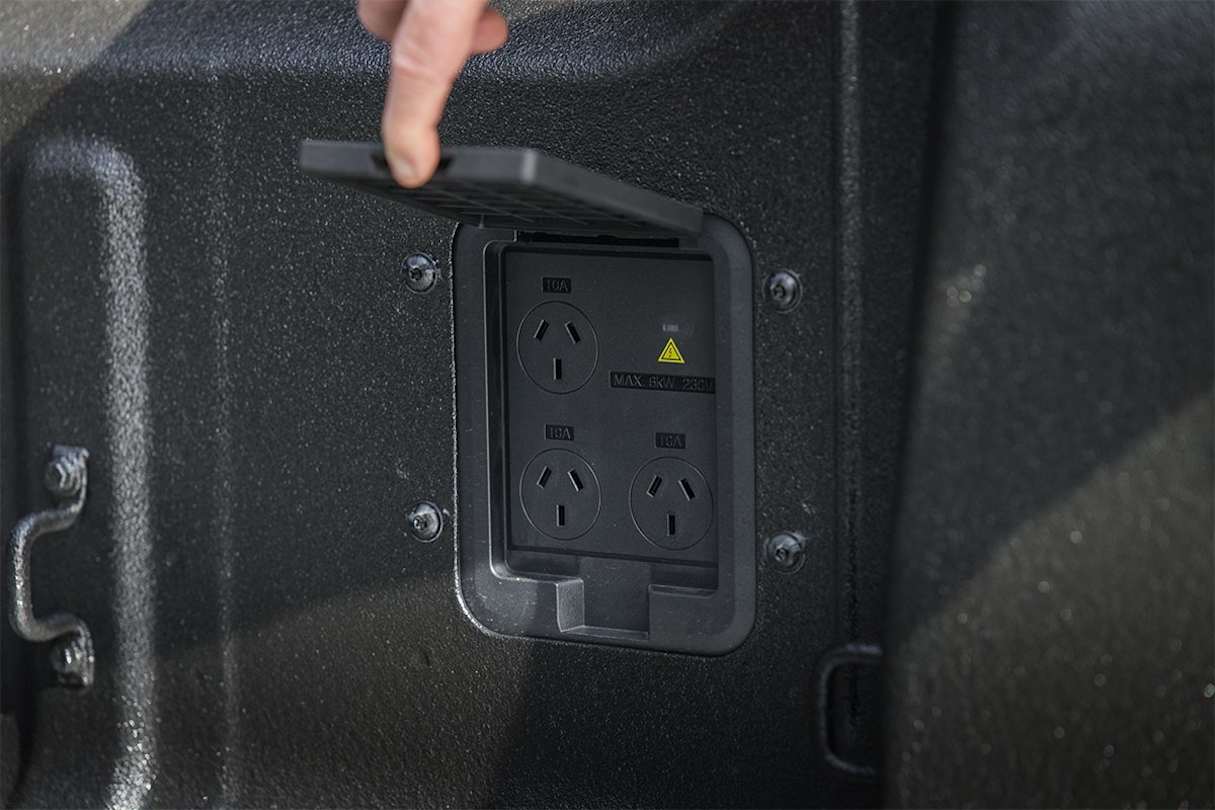
It does have steel bash plates on the underbody, but what concerns me is that the battery pack – positioned about midway along the Shark 6’s undercarriage, where you have the shallow ramp-over angle – is only shielded by a piece of foam and a bash plate. It seems vulnerable to damage to me, especially if you're trying to tackle rock steps, even rock steps that aren’t particularly severe. You wouldn't want to inadvertently give that battery a solid bump against the ground or a rock or a tree stump because then, if the battery sustains any damage, you might be in some serious strife.
The Shark 6 also doesn't have a lot of wheel travel – there’s no live axle moving fully up and down on this vehicle – and wheels are often left dangling in the air through even shallow moguls but despite this, this ute, as standard, is very effective in light to moderate off-roading. Give yourself time to become familiar with how the vehicle operates in off-road scenarios, which modes best suit different terrain types, and how to optimise steering inputs, throttle use etc.
Payload is listed as 790kg and that's a little shy of what some other dual-cab utes are able to carry. Start adding people, gear and pets – not to mention aftermarket accessories – and you’ll swiftly be over legal limits. Always keep those figures in mind – gross vehicle mass, payload etc. – because all of those numbers come in handy when you're trying to figure out how much you can legally carry onboard your vehicle.
In summation, the Shark 6 could tackle off-road terrain that’s a little bit more difficult, but the Shark 6 will need, at the least, a decent set of all-terrain tyres and, if you want to go harder, a suspension upgrade.
Let’s leave a full-blown software update – that delivers an off-road traction control system capable of producing some kind of approximation of low-range gearing and diff locks – to BYD.
Efficiency – What is its fuel consumption? What is its driving range? 8/10
8 / 10
The Shark 6’s official fuel consumption is listed as 2.0L/100km and it has a listed combined driving range – petrol and electric – of 800km.
The Shark 6 has a 30kWh battery and the petrol engine and regenerative braking feed power into that battery during general driving.
I recorded 4.0L/100km and 16.8kWh/100km on this test.
The Shark 6 has a 60L fuel tank and I reckon you can reasonably expect a combined driving range – full-tank and full-charge – of about 700km.
Electric-only driving range is claimed to be 100km. I consistently used 75 per cent over 80km (dropping the Shark 6’s charge from 100% to 25%), so I reckon that 100km range figure is close to accurate.
Warranty & Safety Rating
Safety – What safety equipment is fitted? What is its safety rating? 8/10
8 / 10
The BYD Shark 6 has the maximum five-star ANCAP safety rating.
As standard it has dual front airbags, dual side airbags and curtain airbags (that cover both rows), and far-side airbags for the driver.
Driver-assist tech includes AEB, rear cross-traffic alert, lane-departure warning/intervention, blind-spot warning/intervention, adaptive cruise control and more.
Ownership – What warranty is offered? What are its service intervals? What are its running costs? 7/10
7 / 10
All new Shark 6s are covered by BYD’s six-year/150,000km warranty, which splits the offers of its Ford and GWM rivals.
The Shark 6's battery pack and drive unit are covered for eight years or 160,000 km, whichever occurs first, with a guarantee of at least 70% battery capacity retention.
After the free first service appointment at six months/3500km, servicing is then scheduled at 12-month/20,000km intervals, with the lowest cost being $351 and the highest $923.
Verdict
The BYD Shark 6 signals a big step forward for the plug-in hybrid electric ute market in terms of quality, comfort and all-round usability.
It’s good value in an increasingly expensive car market, it’s well built with a real premium look and feel, and it’s very quiet, refined and comfortable on-road.
The bonus is that the Shark 6 is actually quite impressive off-road, as long as it’s driven within its scope of capability: light to moderate off-road conditions – that is stick to well-maintained dirt tracks in dry weather and avoid ‘4WD/ high ground clearance only' tracks, prolonged sand driving or rock crawling.
Ultimately, the Shark 6’s refinement, on-road performance, and overall driveability outweigh its off-road limitations.





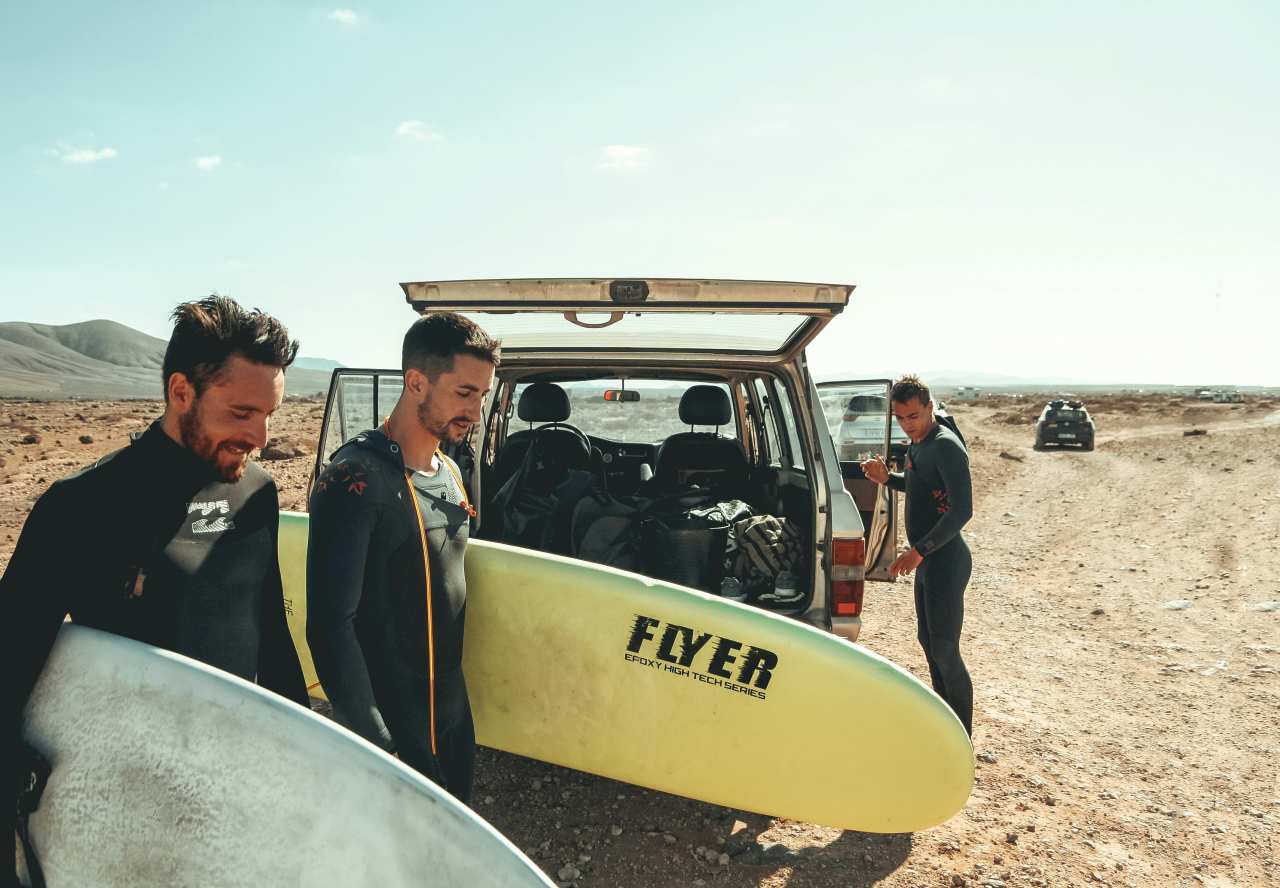



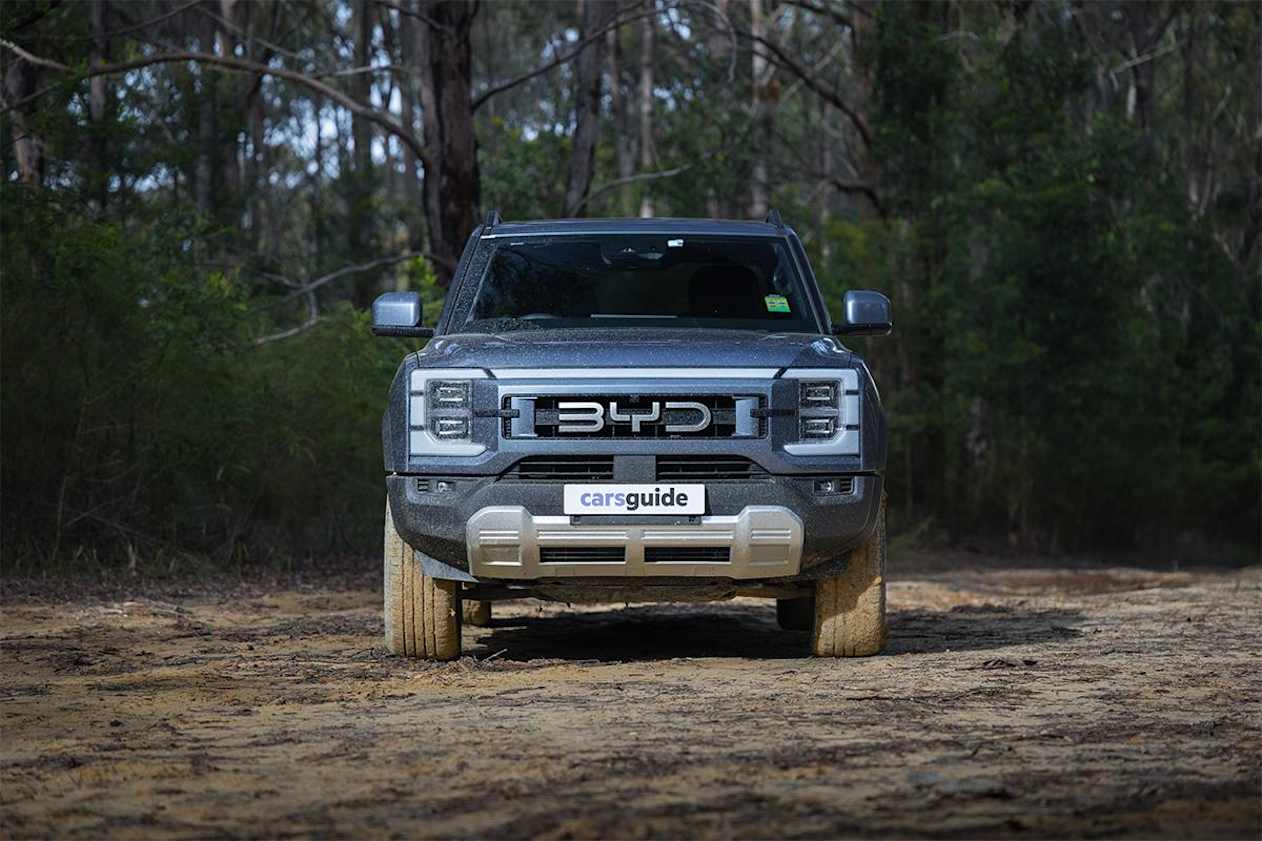





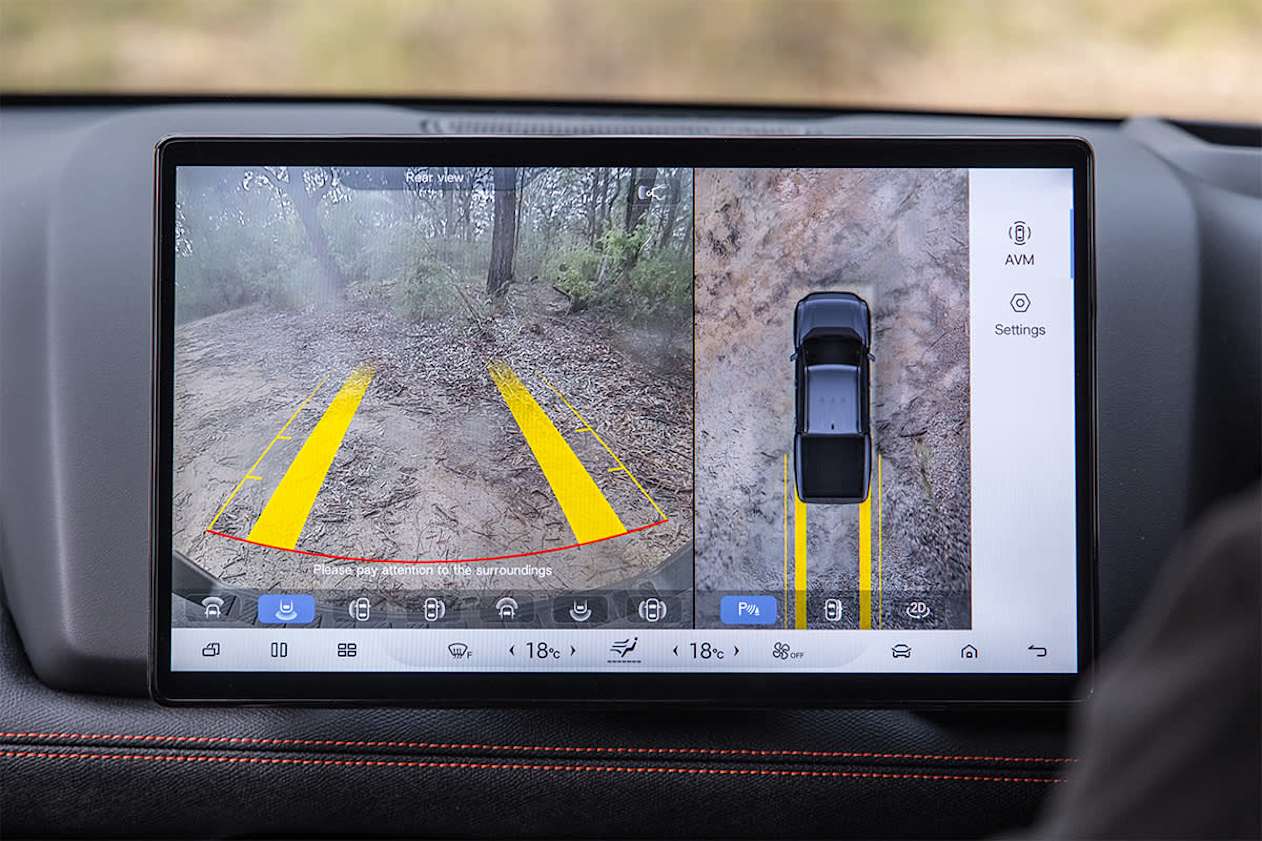



.jpg)




